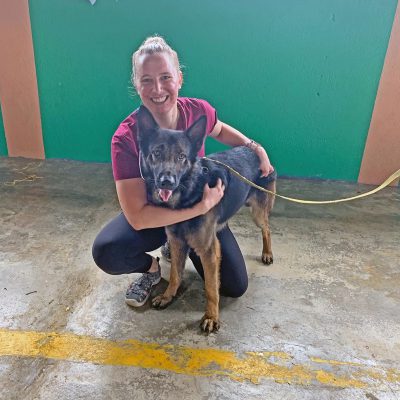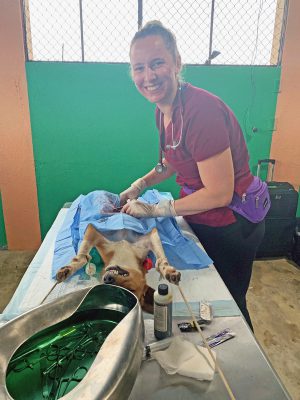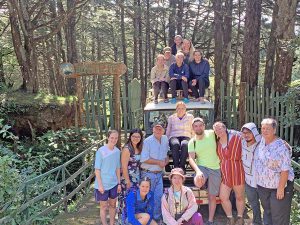By Alli Harju, DVM Class of 2021

My mission trip to Costa Rica was a life changing experience that I will never forget. Prior to the trip, I was extremely nervous about traveling abroad—I had only ever traveled to Canada and had never had to use my passport—and working with a group of people I’d never met. Regardless of my fears, I knew it was important for my personal growth and veterinary skills that I go on this trip.
For most of the week we stayed at the Pasteje Ranch. It’s a private ranch near Heredia, Costa Rica, owned by a veterinarian who does missions work in Costa Rica. We spent the first few days taking care of his dairy goats. We performed physical exams, vaccinations, and trimmed the hooves of all of the goats on the farm.

We also removed Controlled Internal Drug Release (CIDR) devices and gave injections to 10 goats to help synchronize and induce ovulation. These goats were then used for an artificial insemination class taught by Dr. LeeAnn Fosdick for a group of 20–30 Costa Rican veterinary students. Before the class, we got to have a meal with these veterinary students and learn about veterinary medicine in Costa Rica. We all got to listen in on the class and assist with helping students find the cervix and helping inseminate the goats. Prior to this, I had barely worked with goats. Now, I feel comfortable handling, providing basic veterinary care to, and assisting with inseminating goats. It was amazing to learn directly from Dr. LeeAnn Fosdick, who is considered the goat expert of Michigan, and has worked with goats for more than 30 years.

After the artificial insemination class, we traveled to San Ramon, which is in northern Costa Rica close to the border between Costa Rica and Nicaragua. We held the spay and neuter clinic in a school gymnasium in San Ramon. When we arrived, people were already in line to get vaccines, preventative medicine, and castrations for their pets.
My time was divided between helping in surgery and helping with physical exams and vaccinations. When I assisted with surgery, I got to scrub in on spays and neuters of dogs and cats with a shelter veterinarian who taught me her technique. I also was able to step in and help with a goat neuter. At the end of the trip, I was able to perform a dog spay and neuter alone, with a veterinarian overseeing me.

When I assisted with physical exams and vaccinations, I worked directly with Costa Ricans and explained what I was doing in Spanish. We provided core vaccines, dewormer, and prevention to all the animals we saw. Unlike other Spanish speaking countries, very few people speak English in Costa Rica, so the language barrier went both ways. This made it more difficult to assist people but pushed me to improve my Spanish speaking skills. I was able to increase my Spanish literacy and by the end of the trip, I could communicate effectively with the Costa Ricans. Other students even came to me for help when they were struggling with the language barrier and I was able to translate for them.

I fell in love with the country and people of Costa Rica during this trip and learned how rewarding high volume spay and neuter operations can be. I gained confidence in my surgical and communication skills. I was able to communicate with Costa Ricans, learn about veterinary medicine in Costa Rica, and work well with a group of 21 veterinary professionals that I had only met a few days prior.
This trip helped me see a different side of veterinary medicine and made me reevaluate my interest in shelter medicine and missionary work. I am so grateful I was given this opportunity and look forward to applying everything I learned to my upcoming clinical rotations.
